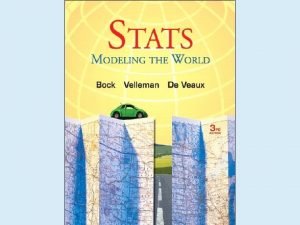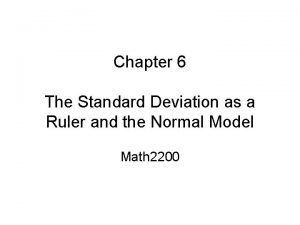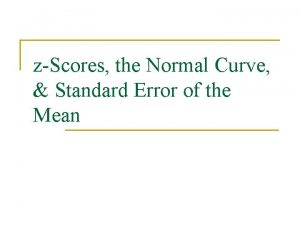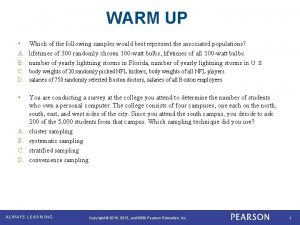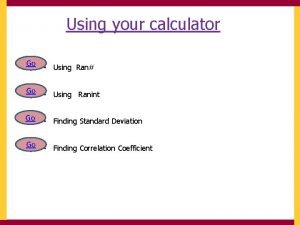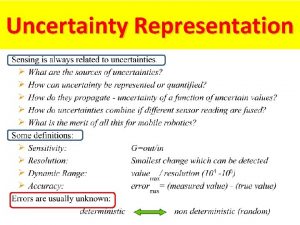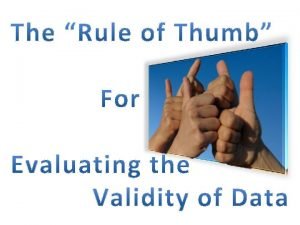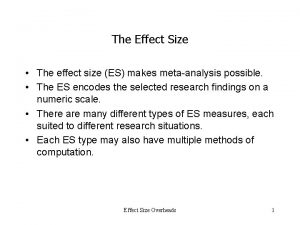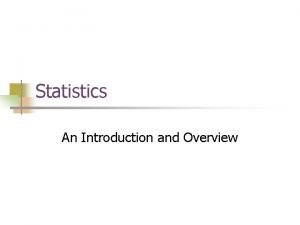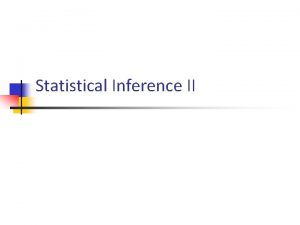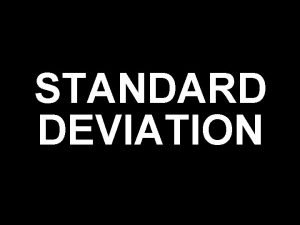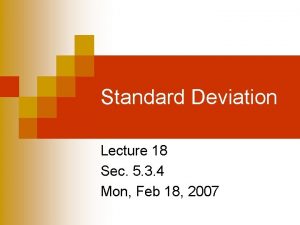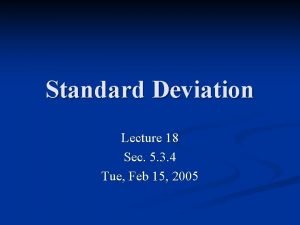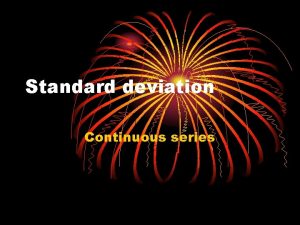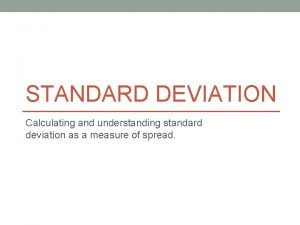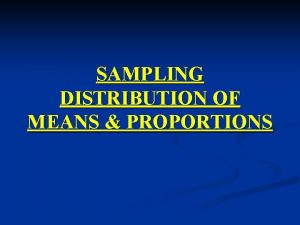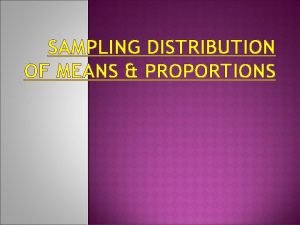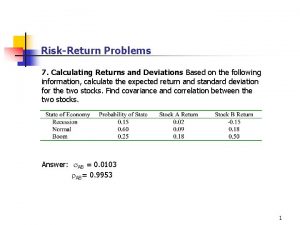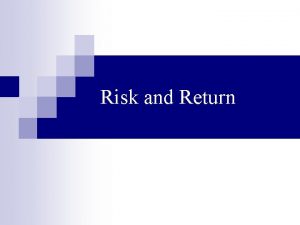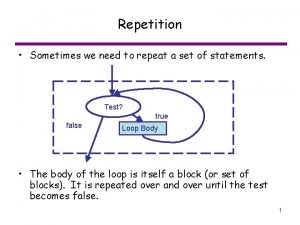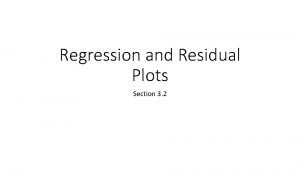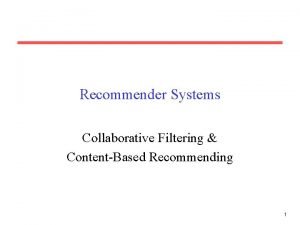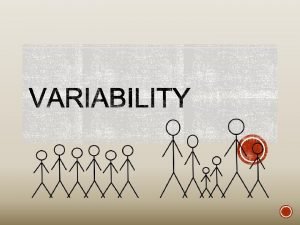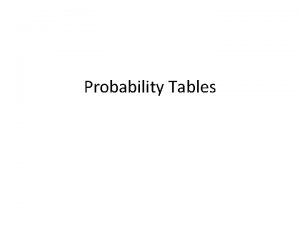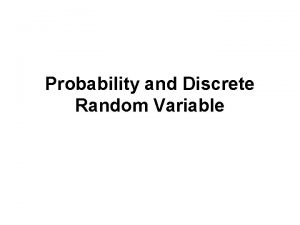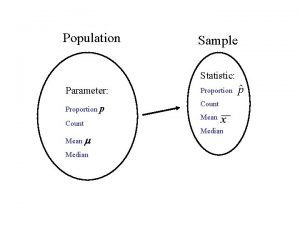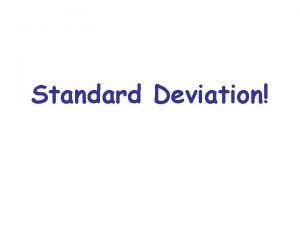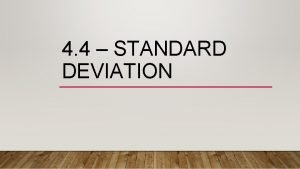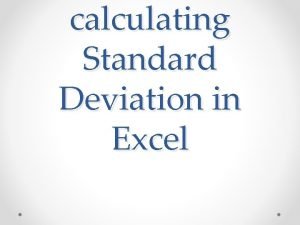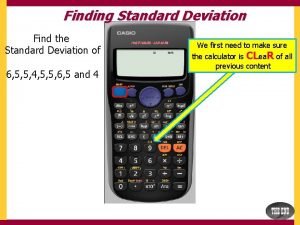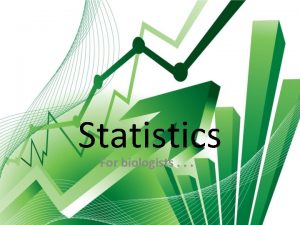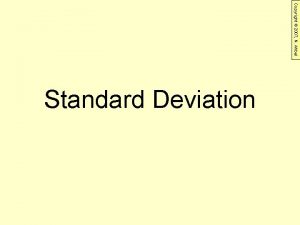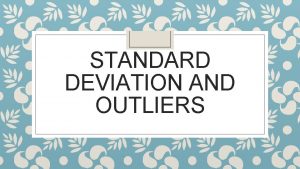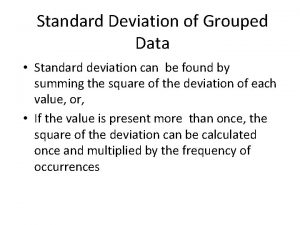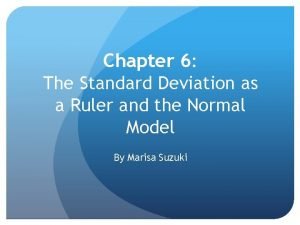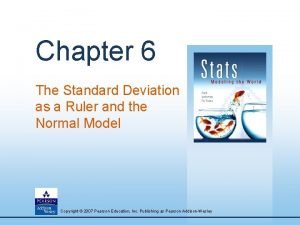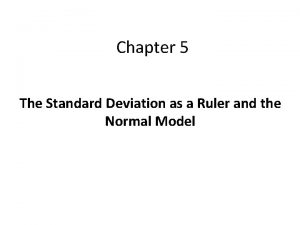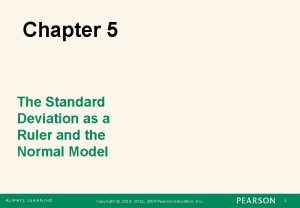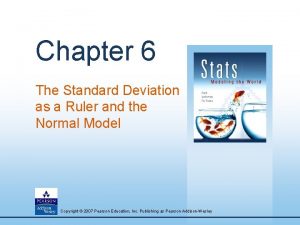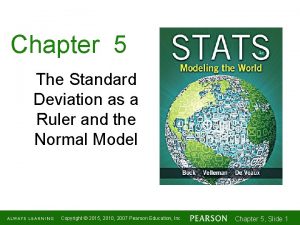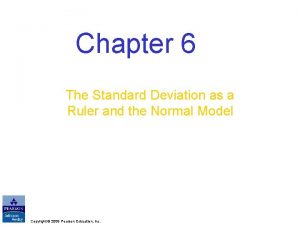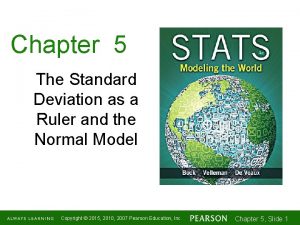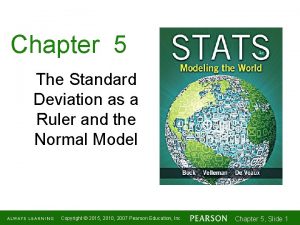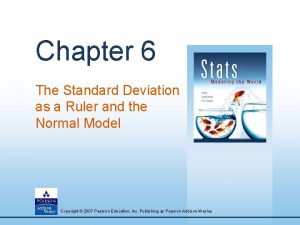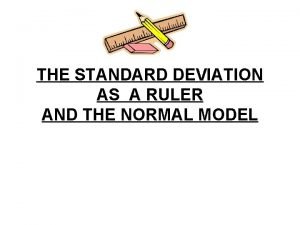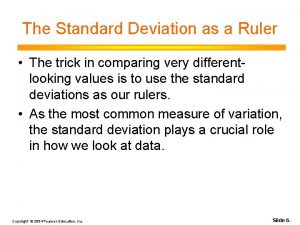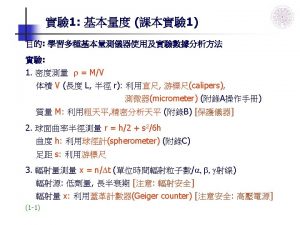Chapter 6 The Standard Deviation as a Ruler


































- Slides: 34


Chapter 6 The Standard Deviation as a Ruler and the Normal Model Copyright © 2010 Pearson Education, Inc.

The Standard Deviation as a Ruler n n n The trick in comparing very different-looking values is to use standard deviations as our rulers. The standard deviation tells us how the whole collection of values varies, so it’s a natural ruler for comparing an individual to a group. As the most common measure of variation, the standard deviation plays a crucial role in how we look at data. Copyright © 2010 Pearson Education, Inc. Slide 6 - 3

Standardizing with z-scores n n We compare individual data values to their mean, relative to their standard deviation using the following formula: We call the resulting values standardized values, denoted as z. They can also be called z-scores. Copyright © 2010 Pearson Education, Inc. Slide 6 - 4

Standardizing with z-scores (cont. ) n n n Standardized values have no units. z-scores measure the distance of each data value from the mean in standard deviations. A negative z-score tells us that the data value is below the mean, while a positive z-score tells us that the data value is above the mean. Copyright © 2010 Pearson Education, Inc. Slide 6 - 5

Benefits of Standardizing n n Standardized values have been converted from their original units to the standard statistical unit of standard deviations from the mean. Thus, we can compare values that are measured on different scales, with different units, or from different populations. Copyright © 2010 Pearson Education, Inc. Slide 6 - 6

Shifting Data n Shifting data: n Adding (or subtracting) a constant amount to each value just adds (or subtracts) the same constant to (from) the mean. This is true for the median and other measures of position too. n In general, adding a constant to every data value adds the same constant to measures of center and percentiles, but leaves measures of spread unchanged. Copyright © 2010 Pearson Education, Inc. Slide 6 - 7

Shifting Data (cont. ) n The following histograms show a shift from men’s actual weights to kilograms above recommended weight: Copyright © 2010 Pearson Education, Inc. Slide 6 - 8

Rescaling Data n Rescaling data: n When we divide or multiply all the data values by any constant value, all measures of position (such as the mean, median and percentiles) and measures of spread (such as the range, IQR, and standard deviation) are divided and multiplied by that same constant value. Copyright © 2010 Pearson Education, Inc. Slide 6 - 9

Rescaling Data (cont. ) n The men’s weight data set measured weights in kilograms. If we want to think about these weights in pounds, we would rescale the data: Copyright © 2010 Pearson Education, Inc. Slide 6 - 10

Back to z-scores n Standardizing data into z-scores shifts the data by subtracting the mean and rescales the values by dividing by their standard deviation. n Standardizing into z-scores does not change the shape of the distribution. n Standardizing into z-scores changes the center by making the mean 0. n Standardizing into z-scores changes the spread by making the standard deviation 1. Copyright © 2010 Pearson Education, Inc. Slide 6 - 11

Examples: Suppose the class took a 40 point quiz. Results show: Mean Median IQR SD Min Q 1 30 32 8 6 12 27 Suppose you got a 35. What happens to each of the statistics if… n I decide to weight the quiz as 50 points and will add 10 points to every score. Your score is now a 45. n I decide to weight the quiz as 80 points and double each score. Your score is now a 70. n I decide to count the quiz as 100 points; I’ll double each score and add 20 points. Your score is now 90. Copyright © 2010 Pearson Education, Inc. Slide 6 - 12

Examples: Now look at Chapter 6 #5, 7, and 8. Work on these problems with your group members. Copyright © 2010 Pearson Education, Inc. Slide 6 - 13

When Is a z-score BIG? n n A z-score gives us an indication of how unusual a value is because it tells us how far it is from the mean. A data value that sits right at the mean, has a zscore equal to 0. A z-score of 1 means the data value is 1 standard deviation above the mean. A z-score of – 1 means the data value is 1 standard deviation below the mean. Copyright © 2010 Pearson Education, Inc. Slide 6 - 14

When Is a z-score BIG? n n n How far from 0 does a z-score have to be interesting or unusual? There is no universal standard, but the larger a zscore is (negative or positive), the more unusual it is. Remember that a negative z-score tells us that the data value is below the mean, while a positive z-score tells us that the data value is above the mean. Copyright © 2010 Pearson Education, Inc. Slide 6 - 15

When Is a z-score Big? (cont. ) n n There is no universal standard for z-scores, but there is a model that shows up over and over in Statistics. This model is called the Normal model (You may have heard of “bell-shaped curves. ”). Normal models are appropriate for distributions whose shapes are unimodal and roughly symmetric. These distributions provide a measure of how extreme a z-score is. Copyright © 2010 Pearson Education, Inc. Slide 6 - 16

When Is a z-score Big? (cont. ) n n n There is a Normal model for every possible combination of mean and standard deviation. n We write N(μ, σ) to represent a Normal model with a mean of μ and a standard deviation of σ. We use Greek letters because this mean and standard deviation are not numerical summaries of the data. They are part of the model. They don’t come from the data. They are numbers that we choose to help specify the model. Such numbers are called parameters of the model. Copyright © 2010 Pearson Education, Inc. Slide 6 - 17

When Is a z-score Big? (cont. ) n n Summaries of data, like the sample mean and standard deviation, are written with Latin letters. Such summaries of data are called statistics. When we standardize Normal data, we still call the standardized value a z-score, and we write Copyright © 2010 Pearson Education, Inc. Slide 6 - 18

When Is a z-score Big? (cont. ) n n Once we have standardized, we need only one model: n The N(0, 1) model is called the standard Normal model (or the standard Normal distribution). Be careful—don’t use a Normal model for just any data set, since standardizing does not change the shape of the distribution. Copyright © 2010 Pearson Education, Inc. Slide 6 - 19

When Is a z-score Big? (cont. ) n n When we use the Normal model, we are assuming the distribution is Normal. We cannot check this assumption in practice, so we check the following condition: n Nearly Normal Condition: The shape of the data’s distribution is unimodal and symmetric. n This condition can be checked with a histogram or a Normal probability plot (to be explained later). Copyright © 2010 Pearson Education, Inc. Slide 6 - 20

The 68 -95 -99. 7 Rule n n Normal models give us an idea of how extreme a value is by telling us how likely it is to find one that far from the mean. We can find these numbers precisely, but until then we will use a simple rule that tells us a lot about the Normal model… Copyright © 2010 Pearson Education, Inc. Slide 6 - 21

The 68 -95 -99. 7 Rule (cont. ) n It turns out that in a Normal model: n about 68% of the values fall within one standard deviation of the mean; n about 95% of the values fall within two standard deviations of the mean; and, n about 99. 7% (almost all!) of the values fall within three standard deviations of the mean. Copyright © 2010 Pearson Education, Inc. Slide 6 - 22

The 68 -95 -99. 7 Rule (cont. ) n The following shows what the 68 -95 -99. 7 Rule tells us: Copyright © 2010 Pearson Education, Inc. Slide 6 - 23

The First Three Rules for Working with Normal Models n n Make a picture. And, when we have data, make a histogram to check the Nearly Normal Condition to make sure we can use the Normal model to model the distribution. Copyright © 2010 Pearson Education, Inc. Slide 6 - 24

Finding Normal Percentiles by Hand n n When a data value doesn’t fall exactly 1, 2, or 3 standard deviations from the mean, we can look it up in a table of Normal percentiles. Table Z in Appendix D provides us with normal percentiles, but many calculators and statistics computer packages provide these as well. Copyright © 2010 Pearson Education, Inc. Slide 6 - 25

Finding Normal Percentiles by Hand (cont. ) n n Table Z is the standard Normal table. We have to convert our data to z-scores before using the table. The figure shows us how to find the area to the left when we have a z-score of 1. 80: Copyright © 2010 Pearson Education, Inc. Slide 6 - 26

From Percentiles to Scores: z in Reverse n n Sometimes we start with areas and need to find the corresponding z-score or even the original data value. Example: What z-score represents the first quartile in a Normal model? Copyright © 2010 Pearson Education, Inc. Slide 6 - 27

From Percentiles to Scores: z in Reverse (cont. ) n n n Look in Table Z for an area of 0. 2500. The exact area is not there, but 0. 2514 is pretty close. This figure is associated with z = – 0. 67, so the first quartile is 0. 67 standard deviations below the mean. Copyright © 2010 Pearson Education, Inc. Slide 6 - 28

Are You Normal? How Can You Tell? n n When you actually have your own data, you must check to see whether a Normal model is reasonable. Looking at a histogram of the data is a good way to check that the underlying distribution is roughly unimodal and symmetric. Copyright © 2010 Pearson Education, Inc. Slide 6 - 29

Are You Normal? How Can You Tell? (cont. ) n n A more specialized graphical display that can help you decide whether a Normal model is appropriate is the Normal probability plot. If the distribution of the data is roughly Normal, the Normal probability plot approximates a diagonal straight line. Deviations from a straight line indicate that the distribution is not Normal. Copyright © 2010 Pearson Education, Inc. Slide 6 - 30

Are You Normal? How Can You Tell? (cont. ) n Nearly Normal data have a histogram and a Normal probability plot that look somewhat like this example: Copyright © 2010 Pearson Education, Inc. Slide 6 - 31

Are You Normal? How Can You Tell? (cont. ) n A skewed distribution might have a histogram and Normal probability plot like this: Copyright © 2010 Pearson Education, Inc. Slide 6 - 32

What Can Go Wrong? n Don’t use a Normal model when the distribution is not unimodal and symmetric. Copyright © 2010 Pearson Education, Inc. Slide 6 - 33

What Can Go Wrong? (cont. ) n n n Don’t use the mean and standard deviation when outliers are present—the mean and standard deviation can both be distorted by outliers. Don’t round your results in the middle of a calculation. Don’t worry about minor differences in results. Copyright © 2010 Pearson Education, Inc. Slide 6 - 34
 Standard deviation as a ruler and the normal model
Standard deviation as a ruler and the normal model Standard deviation as a ruler and the normal model
Standard deviation as a ruler and the normal model Mean absolute devation
Mean absolute devation Standard error in the mean
Standard error in the mean Standard error definition
Standard error definition Standard deviation formula in grouped data
Standard deviation formula in grouped data Types of shoplifters pie chart
Types of shoplifters pie chart Variance formula in standard deviation
Variance formula in standard deviation Ran# in calculator
Ran# in calculator Standard deviation ap biology
Standard deviation ap biology Desmos standard deviation
Desmos standard deviation Uncertainty propagation
Uncertainty propagation Xi in standard deviation formula
Xi in standard deviation formula Pooled standard deviation
Pooled standard deviation Standard deviation 66 95 99
Standard deviation 66 95 99 99% z*
99% z* Standard deviation sign
Standard deviation sign Standard deviation formula
Standard deviation formula Standard deviation alternate formula
Standard deviation alternate formula Standard deviation in continuous series
Standard deviation in continuous series Standard deviation sig figs
Standard deviation sig figs Understanding standard deviation
Understanding standard deviation Standard deviation of sampling distribution of p hat
Standard deviation of sampling distribution of p hat Sampling distribution
Sampling distribution How to calculate expected return
How to calculate expected return Portfolio standard deviation
Portfolio standard deviation Standard deviation formula java
Standard deviation formula java Residual plot ti 84
Residual plot ti 84 Regresi
Regresi Covariance and standard deviation
Covariance and standard deviation What is a quantitative measure of variability
What is a quantitative measure of variability Normal probability distribution table
Normal probability distribution table Standard deviation of discrete random variable
Standard deviation of discrete random variable What is discrete random variable
What is discrete random variable What is a sample in statistics
What is a sample in statistics
